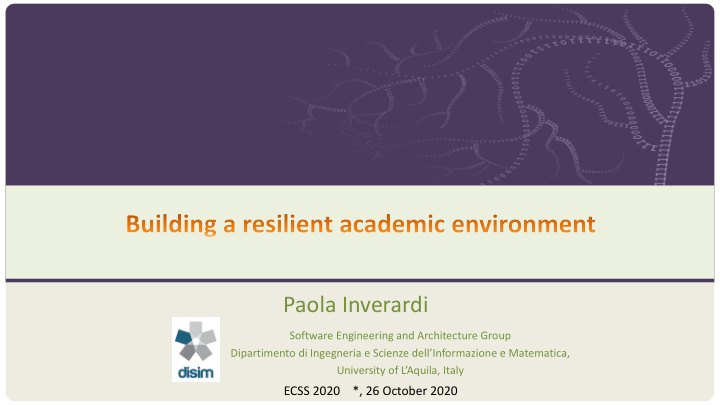



Paola Inverardi Software Engineering and Architecture Group Dipartimento di Ingegneria e Scienze dell’Informazione e Matematica, University of L’Aquila, Italy ECSS 2020 *, 26 October 2020
Who I am • Professor of computer Science at University of L’Aquila, field of research Software Engineer. • Head of Departments, Dean Faculty of Science • 2013-2019 Rector of University of L’Aquila • 7 Departments ( Humanities, Civil Eng. And Architecture, Industrial Engineering, Information Science and Engineering and Mathematics, Physics and Chemistry, Biotechnology and Psychology and Medicine, Biology and Environmental Sciences and Medicine ) • More than 1000 employees (550+450) • 19.000 students 2
My experience in disasters recovery • April 2009 earthquake: – 309 dead, 55 university students – 60000 people assisted and displaced – No building available for the University, no accomodation for students – I was dean of Faculty of science (CS, Maths, Phisics, Chemistry, Biology, Environmental Sciences) – May 2009 back in operation also in presence. Teaching spread all over the region and close regions hosted in various institutions. Research and researchers re- located in host institutions all over Italy. – October 2009 teaching back in L’Aquila in 1 original building plus rented and adapted industrial buildings. – 2020 still missing few of the original buildings – Research labs were left behind … 3
2009: The use of digital means • First action in 2 days, was the set up of a temporary web site … communication • Tracing of where the students were displaced. Identification of sites easily reacheable from the majority of students, organization of temporary teaching sites. Taking care of transportation, meals, accomodation etc • Administrative offices, mostly on distance alternating in presence in a temporary site (the whole University in the big hall of a less damaged building of Faculty of Science) • Research on distance and then hosted outside L’Aquila 4
Resilience: a long term process • Very long process to get back to normality, 4-5 years to complete the full temporary recovery, then the reconstruction period (not yet completed). • Emergency governamental plan to sustain the University 2009- 2014 then a smooth re-entering in the (new) system. • We were on the track to normality …. But … 5
A new series of earthquakes L • August 2016, October 2016, Juanuary 2017 quakes + exceptional snow • No physical damages in L’Aquila but a psycological breakdown in the community • We were not robust enough in the organization: communication problems (re-assuring yes/not, responsability of thousands of people, working conditions, be well prepared to face minor events, cope with the memory of the big destructive event) 6
Change of strategy • Security as first class objective: it is a continuos investment – Buildings – Education of students and personnel – Security department – Budget, budget, budget • Ability to timely react as an organization – Crisis unit: rector, delegate to security, security people, representative of teaching stuff, epidiomology specialist. But small – protocol to deal with crisis pre-post phases • Communication skills – After 2016 we recruited a specialist in communication of risks and we followed a 1 year course. We … (rector, some head of department, security personal, communication people) 7
2019-2020 the pandemy • Not anymore rector but member of the crisis unit • Many meetings before the lockdown, we started preparing for alternatives involving Departments, notably the CS and Engineering Department. During the lockdown very quick transition to distance learning, exams, graduations. • Research moved on distance as well, but labs (especially life science ones) remained active. • Administrative work mainly on distance, we were already trained and have experimented in the post earthquake period various form of agile work. The digitalisation of all administrative processes was crucial. 8
October 2020: answers and questions J Back in presence for most of the teaching activity with very strict protocols • Research back in the labs with restricted access and protocols • Distance learning coupled with in presence • Very positive feedback from teachers and students, strong will to go back to presence • although leveraging on the on distance experience. Fear of becoming a distance learning university A big role is played by the context. Universities can survive and be the driving force for the • renaissance of the context (our experience) but distance learning can change this model. What can we do to reaffirm the in presence role of Universities? We need to reinvent the • teaching experience putting value on the in presence experience. How? Few ideas … still from our experience The town under reconstruction as the living lab for our students • 9
And research? • Seminars, conferences, PhDs … – Can the context play an active role? Not just a container. • Environment, industries, building, history, pollution, (non) smart cities, hospitals, social reality, culture, archeology, community life … 10
Pro and Cons • On line meetings are ok. Saving in all dimension (time, pollution, money, family stress, etc) • Conferences not ok. Difficult to cope with 3 day off even trying. Miss the social dimension, important to establish new connections, exchange freely opinion and ideas, listen at new interesting research contribution (I have one hour free in between my sessions, jump in another one. There are no free hours at home/office) • Research is already international and large scale: Human Genome project, observation of gravitational waves, etc. 11
Recommend
More recommend